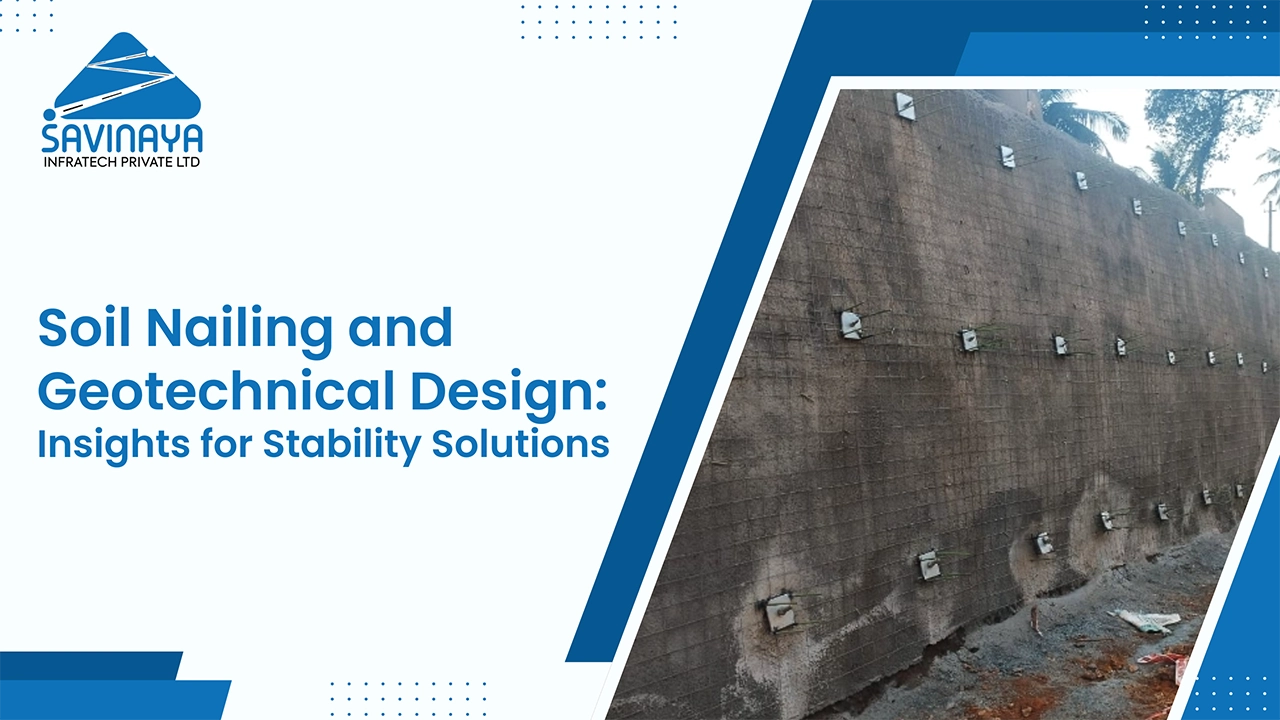Soil Nailing and Geotechnical Design: A Solution for Stability
Ensuring soil stability is a critical aspect of geotechnical engineering, as unstable soil can lead to landslides, retaining wall failures, and excavation collapses. Among various ground improvement methods, soil nailing has emerged as an efficient and cost-effective technique for stabilizing slopes, supporting excavations, and reinforcing retaining walls.
This article explores the fundamentals of soil nailing, its advantages over other techniques, and its role in modern geotechnical engineering.
What is Soil Nailing?
Soil nailing is a stabilization technique where steel bars (nails) are inserted into the soil at an angle and secured with grout. This method enhances the strength of the soil, reducing its chances of movement and failure. The process typically involves:
Drilling: Creating holes at specific angles in the soil.
Insertion: Placing soil nails (steel bars) into the drilled holes.
Grouting: Filling the holes with cementitious grout for added strength.
Facing Application: Using shotcrete, mesh, or concrete panels for additional reinforcement.
This technique is widely used in retaining walls, deep excavations, and slope stabilization projects.
Soil Nailing vs. Other Ground Improvement Techniques
While soil nailing is a popular stabilization method, other techniques are also available. Here’s a comparison:
Soil Nailing
Cost-effective and requires minimal excavation.
Fast installation with reduced labor requirements.
Less effective in loose, sandy, or highly erodible soils.
Anchored Retaining Walls
Provides strong structural support and a long lifespan.
Expensive and requires complex installation.
Sheet Piling
Effective for deep excavations and waterlogged soil conditions.
High material costs and creates significant noise pollution during installation.
Gabion Walls
Eco-friendly solution that promotes natural drainage.
Requires large space and extensive material usage.
Reinforced Soil Walls
Strong, durable, and aesthetically flexible.
Needs thorough soil assessment before construction.
Among these, soil nailing stands out as efficient, and minimally invasive method for slope stabilization and excavation support.
Advantages of Using Soil Nailing for Stability Solutions
Why choose soil nailing over other techniques? The key benefits include:
Fast and Efficient Installation: Less time-consuming than other ground improvement methods.
Minimal Excavation Required: Causes less environmental disruption compared to anchored retaining walls.
Versatility: Effective in various soil types and applicable to multiple construction projects.
Enhanced Soil Strength: Increases the load-bearing capacity and mitigates erosion risks, making it ideal for slope stabilization.
Challenges and Considerations in Soil Nailing Design
Despite its benefits, soil nailing presents some challenges:
Soil Suitability: Works best in cohesive or semi-cohesive soils but may be ineffective in loose sand.
Corrosion Risks: Steel nails require corrosion-resistant coatings to maintain durability.
Proper Installation Required: Errors in drilling, grouting, or nail placement can compromise structural stability.
Proper planning, soil analysis, and expert supervision are essential to achieving long-term success in soil nailing applications.
How Savinaya Can Help with Soil Nailing Solutions?
At Savinaya Infra, we specialize in advanced soil nailing techniques for projects requiring slope stabilization, retaining wall reinforcement, erosion control, and deep excavation support. Our expert team provides:
Comprehensive Soil Analysis: Assessing soil conditions to determine the best stabilization strategy.
Customized Design Solutions: Tailoring soil nailing techniques to specific project needs.
Precision Installation: Ensuring proper drilling, grouting, and facing application.
Long-Term Durability: Using high-quality, corrosion-resistant materials for sustainable results.
Whether your project involves highway embankments, underground tunnels, or reinforced retaining walls, our solutions enhance safety, durability, and cost-efficiency.
The Future of Soil Nailing in Geotechnical Engineering
With advancements in construction materials and technology, soil nailing techniques continue to evolve. Key developments include:
Advanced Materials: High-strength steel nails and corrosion-resistant coatings improve durability.
Automated Installation: Robotics and AI are enhancing precision in wall nailing and excavation support.
Eco-Friendly Innovations: Sustainable grouting and green facings are reducing the environmental impact of reinforced soil walls.
Final Thoughts
From retaining walls to slope stabilization, soil nailing techniques offer an effective and cost-efficient way to reinforce soil structures. By enhancing soil stability without extensive excavation, soil nailing is a preferred solution in geotechnical engineering.
As infrastructure projects demand more sustainable and reliable ground reinforcement, soil nailing will remain a key player in ensuring safer roads, tunnels, and embankments.
If your project requires erosion control, deep excavation support, or reinforced soil walls, consider soil nailing techniques for long-term stability and performance.
Looking for expert guidance on soil nailing solutions?
Savinaya Infra is here to help! Contact us today and build with confidence!
Frequently Asked Questions (FAQ)
1. Is Soil Nailing Environmentally Friendly?
Yes, soil nailing is an eco-friendly technique as it minimizes excavation, reduces the need for concrete, and prevents soil erosion, making it a sustainable choice for ground improvement.
2.How Can I Get Started with a Soil Nailing Project?
If you need soil stabilization or geotechnical support, contact Savinaya Infra for professional guidance and soil nailing solutions.
3. How is Soil Nailing Different from Other Stabilization Techniques?
Compared to Anchored Retaining Walls: Soil nailing is more cost-effective but may not be as strong in certain conditions.
Compared to Sheet Piling: Soil nailing requires less excavation but is unsuitable for waterlogged areas.
Compared to Gabion Walls: Soil nailing requires less space and is more adaptable.
4. What is Soil Nailing?
Soil nailing is a ground reinforcement technique used in geotechnical engineering to stabilize slopes, retaining walls, and excavations. It involves inserting steel nails into the soil and securing them with grout to improve soil stability.



Comments
Post a Comment